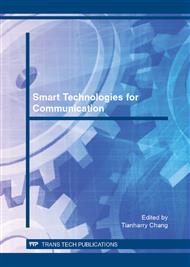[1]
World Wide Web Consortium (W3C). WSDL Specification Version 1. 1. [EB/OL]. http: /www. w3. org/TR/2001/NOTE-wsdl-20010315.
Google Scholar
[2]
K. Verma and A Sheth, Semantically Annotating a Web Service, IEEE Internet Computing 11 (2), March–April 2007, p.83–85.
DOI: 10.1109/mic.2007.48
Google Scholar
[3]
ISO/IEC 19763-3: 2007. Keqing He. http: /www. iso. org/iso/iso_ catalogue/catalogue_tc/ catalogue_detail. htm?csnumber=38637, (2008).
Google Scholar
[4]
Chong Wang, Keqing He, Yangfan He. MFI4Onto: Towards Ontology Registration on the Semantic Web [A]. In Proceedings of 6th International Conference on Computer and Information Technology, CIT 2006, Seoul, 2006, pp.40-46.
DOI: 10.1109/cit.2006.118
Google Scholar
[5]
D. Fensel and C. Bussler, The Web Service Modeling Framework WSMF, Electronic Commerce: Research and Applications, 1 (2002) 113-137.
DOI: 10.1016/s1567-4223(02)00015-7
Google Scholar
[6]
J. Cardoso, C. Bussler, Semantic Web Services and Processes: Semantic Composition and Quality of Service, On the Move to Meaningful Internet Computing and Ubiquitous Computer, Irvine CA, October (2002).
Google Scholar
[7]
M. Paolucci, T. Kawamura, T. Payne, and K. Sycara, Semantic matching of Web Services capabilities, in Proc. of the 1st International Semantic Web Conference(ISWC), (2002).
DOI: 10.1007/3-540-48005-6_26
Google Scholar
[8]
Sycara, K.; J. Lu, M. K.; Widoff, S., Dynamic service matchmaking among agents in open information environments, ACM SIGMOD Record (Special Issue on Semantic Interoperability in Global Information Systems), (1999) 28, No. 1, 47.
DOI: 10.1145/309844.309895
Google Scholar
[9]
Sycara, K.; Widoff, S.; M. Klusch, J. L., (2002), LARKS: Dynamic Matchmaking Among Heterogeneous Software Agents in Cyberspace, Autonomous Agents and Multi- Agent Systems, Vol. 5, 173.
DOI: 10.1023/a:1014897210525
Google Scholar
[10]
Kawamura, T.; Blasio, J. D.; Hasegawa, T., et al., (2003), Preliminary Report of Public Experiment of Semantic Service Matchmaker with UDDI Business Register, 1st International Conference on Service Oriented Computing (ICSOC 2003), Trento, Italy.
DOI: 10.1007/978-3-540-24593-3_15
Google Scholar
[11]
Kawamura, T.; Blasio, J. D.; Hasegawa, T., et al., (2004), Public Deployment of Semantic Service Matchmaker with UDDI Business Registry, 3rd International Semantic Web Conference (ISWC 2004), LNCS 3298.
DOI: 10.1007/978-3-540-30475-3_52
Google Scholar
[12]
Jaeger, M. C.; Tang, S.; Liebetruth, C., The TUB OWL-S Matcher. Available at: http: /ivs. tuberlin. de/Projekte/owlsmatcher/index. html.
Google Scholar
[13]
Li, L.; Horrocks, I., (2003), A software framework for matchmaking based on semantic web technology, 12th International World Wide Web Conference, Budapest, Hungary, ACM Press.
DOI: 10.1145/775152.775199
Google Scholar
[14]
M. Klusch, B. Fries, and K. Sycara, Automated Semantic Web Service discovery with OWLS-MX, in Proc. of the 5th Intl. Joint Conference on Autonomous Agents and Multiagent Systems (AAMAS 2006), Hakodate, Japan. ACM, May 2006, p.915–922.
DOI: 10.1145/1160633.1160796
Google Scholar
[15]
M. Klusch and F. Kaufer, WSMO-MX: A hybrid Semantic Web Service matchmaker, Web Intelli. and Agent Sys., vol. 7, no. 1, p.23–42, (2009).
DOI: 10.3233/wia-2009-0153
Google Scholar
[16]
M. Klusch, P. Kapahnke, and I. Zinnikus, SAWSDL-MX2: A machine-learning approach for integrating Semantic Web Service matchmaking variants, in Proc. of 7th Intl. Conference On Web Services (ICWS 2009), Los Angeles, CA, USA. IEEE, July 2009, p.335.
DOI: 10.1109/icws.2009.76
Google Scholar
[17]
S. A. Oundhakar, K. Verma, K. Sivashanmugam, A. P. Sheth, and J. A. Miller, Discovery of Web Services in a multi-ontology and federated registry environment, Int. J. Web Service Research., vol. 2, no. 3, p.1–32, (2005).
DOI: 10.4018/jwsr.2005070101
Google Scholar
[18]
J. Pathak, N. Koul, D. Caragea, and V. G. Honavar, A framework for Semantic Web Services discovery, in Proc. of the 7th Annual ACM Intl. Workshop on Web Information and Data Management (WIDM 2005), Bremen, Germany. ACM, November 2005, p.45–50.
DOI: 10.1145/1097047.1097057
Google Scholar


